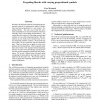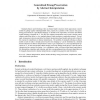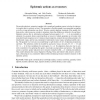LOGCOM
2007
14 years 6 months ago
2007
This paper extends Post’s programme to finite levels of the Ershov hierarchy of ∆2 sets. Our initial characterisation, in the spirit of Post [27], of the degrees of the immune...
LOGCOM
2007
14 years 6 months ago
2007
Recently, the old logical notion of forgetting propositional symbols (or reducing the logical vocabulary) has been generalized to a new notion: forgetting literals. The aim was to...
LOGCOM
2007
14 years 6 months ago
2007
We define a notion of combinatorial labellings, and show that ∆0 2 is the largest boldface pointclass in which every set admits a combinatorial labelling.
LOGCOM
2007
14 years 6 months ago
2007
In this paper we present s1, a family of logics that is useful to disprove propositional formulas by means of an anytime approximation process. The systems follows the paradigm of...
LOGCOM
2007
14 years 6 months ago
2007
Categorisation of objects into classes is currently supported by (at least) two ‘orthogonal’ methods. In logic-based approaches, classifications are defined through ontologi...
LOGCOM
2007
14 years 6 months ago
2007
LOGCOM
2007
14 years 6 months ago
2007
The syntactic approach to epistemic logic avoids the logical omniscience problem by taking knowledge as primary rather than as defined in terms of possible worlds. In this study, ...
LOGCOM
2007
14 years 6 months ago
2007
We provide algebraic semantics together with a sound and complete sequent calculus for information update due to epistemic actions. This semantics is flexible enough to accommoda...
LOGCOM
2007
14 years 6 months ago
2007
The principle sPHPa b (PV (α)) states that no oracle circuit can compute a surjection of a onto b. We show that sPHP (a) P (a)(PV (α)) is independent of PV1(α)+sPHP π(a) Π(a)...
LOGCOM
2007
14 years 6 months ago
2007
In Artificial Intelligence there is a need for reasoning about continuous processes, where assertions refer to time intervals rather than time points. Taking our lead from van Ben...




